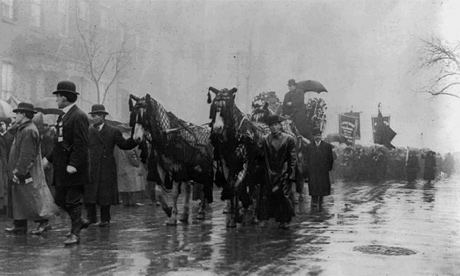America's long and steady march toward a fully disposable workforce continues apace, the Bureau of Labor Statistics reported this week. Union membership is at its lowest point in nearly a century, with just 11.3% of all workers – the same level it was in 1916. To put this in proper historical perspective, union members are as rare today as they were at a time when being one could get you shot to death in a mining camp by the Colorado national guard.
Not that there is a great public outcry to return to the halcyon days of garment factory fires and tubercular slaughterhouses, or workers rallying to demand their bosses take away their pensions and bathroom breaks.Surveys show that most people wish they had more, not less input into their working conditions, and that a majority of non-union workers would choose to join a union, given the opportunity. Most do not get that opportunity, whether due to outright intimidation, or the ongoing shift of large parts of the economy toward part-time, temporary, low-wage and no-benefit jobs.
Union decline is nothing new: it began in the US in the mid 1950s and has been accelerating since the mid 70s. What's new this year is why: while deunionization was long linked to deindustrialization, now union losses are concentrated in government, the last bastion of organized labor. Decades ago, facing factory closings, many unions shifted to the public sector, organizing what were then seen as stable jobs: teachers, firefighters, cops, state-funded healthcare and childcare workers.
Then came the recession, and a new breed of Republican governors who seized the moment as a chance to punish their political opponents. One of the sharpest declines has occurred in Wisconsin, where Governor Scott Walker stripped most state employees of their bargaining rights (notably excluding those unions that had endorsed him).
But if labor markets are adapting to the reality of a mostly union-free America, so too is labor activism. Last year, two of the highest profile labor actions in the country – one-day "flash" strikes at fast food restaurants in New York City, and at Walmart stores nationwide – were coordinated by groups that are not traditional unions: New York Communities for Change and OUR Walmart (though both received union support). And both strikes were carried out without the traditional aim of formal union recognition.
Networks of new, grassroots workers centers – including the Restaurant Opportunities Centers, Retail Action Project, National Day Laborer Organizing Network, and National Domestic Workers Alliance – have grown in sectors which unions have found nearly impossible to organize due to their contingent or informal nature. And their victories – exposing safety and health violations, winning raises and backpay owed to workers, freeing some from virtual domestic slavery – have been achieved largely outside the purview of the body that governs union elections, the National Labor Relations Board.
Just a week before the BLS released its sobering report, Chicago passed a new law imposing some of the strictest sanctions on employers who do not pay workers the wages they are owed. It's an illegal but lightly enforced practice – and appallingly common in many industries, where it is used to force employees to work off-the-clock, as a means to avoid paying overtime rates, or simply as a way not pay staff for work they have done.
I volunteer at one legal clinic for low-income workers called the DC Employment Justice Center. The bulk of cases I've seen over the past decade have involved some form of wage theft perpetrated against construction workers, cleaners, housekeepers, and restaurant kitchen staff – most of them immigrants from Central America.
In one case, a carpenter I interviewed had been hired to install drywall at a building site, and was promised a lump sum payment upon its completion. When he finished the job, the contractor never showed up to pay him.
"Yeah," he told me, "my friends warned me not to work for that guy because he doesn't pay."
"You mean he's known to pay low wages?" I asked.
"No," he laughed, "I mean he doesn't pay his employees at all. Ever."
The Chicago law was passed with union support, but was spearheaded by another non-traditional labor group called Arise Chicago, formed from an interdenominational network of religious leaders. Other improvements have been won in recent years, mostly through class action lawsuits and state- and municipal-level legislation: winning paid sick leave, overtime, and disability compensation, and forcing cities to budget proper funding to enforce wage-hour and health and safety laws.
These victories are significant, and translate into safer jobs and more food on the table for workers. But it's important not to lose sight of what is being lost: an institution of collective agency, and a way for employees to sit down with employers on equal terms and set the conditions for what they will do for eight or more hours every day. The disappearance of that institution and the breakdown of that balance of power between them create the very conditions – from discrimination to workplace accidents to outright theft – that these new worker movements rise up to address.
Labor lawyer Tom Geoghegan once observed that much-maligned trial lawyers thrive when the rule of law breaks down, and when the state, through austerity, outsources its regulatory responsibilities to them. Lay off meat inspectors, and you get whistleblowers and lawsuits instead.
Today, workers still want a fair deal. But now, they have to petition in the courts and at city councils for what they were once able to demand at the bargaining table.

No comments:
Post a Comment